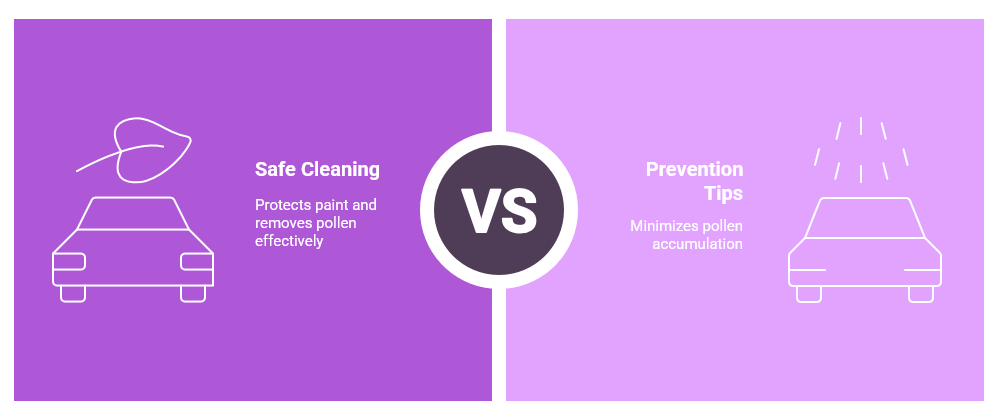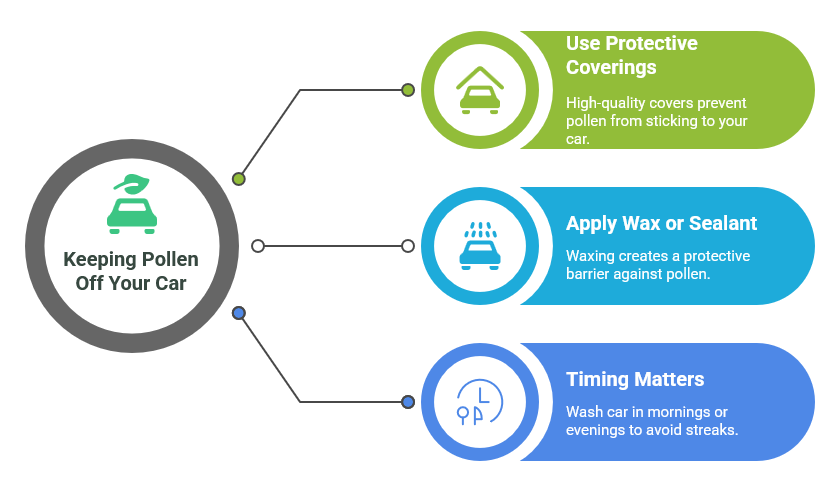Last Updated on April 26, 2025 by Mark S. Taylor
You know that thick, yellow dust blanketing your car every spring? Yeah, pollen season strikes again. I remember one year when my black sedan looked more like a neon green art project—tree pollen had caked on so thick, I panicked thinking it might ruin the paint. Turns out, learning how to get pollen off car isn’t just about aesthetics; it’s about protecting your vehicle too. From safe cleaning methods to prevention tips, I’ll walk you through everything you need to keep your car looking sharp—and pollen-free—all season long. Let’s dive in!

Contents
Understanding Pollen and Its Impact on Your Car
What Is Pollen and Why Does It Stick to Cars?
You know that annoying dust storm your car gets caught in every spring? That’s pollen, nature’s way of saying, “Let’s make more plants!” Pollen comes in different types—tree, grass, and weed—and they all have their own seasons. Trees kick things off in spring, grass takes the baton in summer, and weeds finish strong in fall. Quick answer: Tree pollen is stickier because it’s designed to cling to insects for pollination, while grass and weed pollen are lighter and more powdery.
Here’s a fun fact: pollen doesn’t just land on your car—it sticks because of static electricity. Think of it like your car wearing socks on a carpet; the surface naturally attracts tiny particles. And if there’s tree sap mixed in, it’s like glue for pollen. I once parked under an oak tree during peak pollen season, and my car looked like it had been shrink-wrapped in yellow glitter. Not fun. But hey, now you know why it happens!
Can Pollen Damage Car Paint?
So, can pollen actually hurt your car’s paint? The short answer: Yes, but only if you ignore it. When pollen mixes with rain or morning dew, it can turn into a slightly acidic film. Over time, this can etch or dull your car’s finish. Imagine leaving a spilled soda on your hood—it might not seem bad at first, but leave it too long, and you’ll see the damage.
I learned this the hard way one summer when I skipped washing my car for weeks (oops). When I finally got around to cleaning it, there were faint spots where the paint looked uneven. Turns out, the pollen had bonded with moisture and started eating away at the protective wax layer. Lesson learned: safe cleaning methods are key. Avoid abrasive tools or harsh chemicals—they’ll do more harm than good. Instead, use pH-neutral soap and microfiber towels to lift the pollen without scratching.
Pro tip: Studies show some pollens have mild acidic properties, which is why regular maintenance matters. If you’re unsure about how to clean safely, check out trusted car care guides or ask a pro. Your car’s paint will thank you!
Why Safe Cleaning Methods Matter
Let’s talk about why being careful when cleaning pollen off your car is so important. Quick answer: Using the wrong tools or techniques can scratch your paint, and trust me, that’s not a mistake you want to make. I learned this the hard way one summer when I grabbed an old kitchen sponge to clean my car. Big mistake. The rough side of the sponge left tiny swirl marks all over the hood—it looked like someone had taken sandpaper to it. Lesson learned? Always use safe cleaning methods, especially during pollen season.
Pollen itself might seem harmless, but if you’re scrubbing with abrasive materials or using harsh chemicals, you’re risking more damage than the pollen ever could. For example, will pollen damage car paint? Not directly, but improper cleaning absolutely can. That’s why safe car washing techniques for pollen are crucial. Think of your car’s paint like your skin—gentle care keeps it looking fresh and healthy.
Here’s my advice: Stick to microfiber towels, pH-neutral car wash soap, and a two-bucket system (one for clean water, one for soapy). These simple steps protect your car’s finish while getting rid of that stubborn yellow dust. After all, no one wants to trade pollen stains for scratches, right? Take it from me—your car will thank you in the long run.

How to Clean Pollen Off Your Car Safely
A. Washing Method
Let’s start with the basics: washing your car to get rid of loose pollen. Quick tip: Always use microfiber towels, a two-bucket system, and pH-neutral car wash soap—these are the MVPs for safe cleaning. Why? Because regular soap or old rags can scratch your paint, and no one wants that. I once skipped the two-bucket method and ended up dragging dirt across my hood. Rookie mistake.
Here’s how to do it right: Rinse your car first to loosen the pollen particles. Then, wash from top to bottom—that way, dirt slides down and doesn’t get rubbed back onto clean areas. This technique is hands-down the best car wash for pollen because it minimizes scratches. And don’t forget to dry with a fresh microfiber towel to avoid water spots. Trust me, it makes all the difference.
B. Vacuuming Interior Surfaces
Pollen doesn’t just stay outside—it sneaks inside too. Seats, carpets, and even dashboards become pollen magnets. One time, I noticed my allergies flaring up every time I got in my car. Turns out, pollen had made itself at home on my floor mats. Gross, right?
The fix? Grab a vacuum cleaner with upholstery attachments. These tools are perfect for sucking up pollen from fabric seats and tight spaces. For hard-to-reach spots like vents or crevices, use a small brush attachment or even a makeup brush (don’t knock it till you try it). Cleaning pollen off car interior surfaces might feel tedious, but your sinuses will thank you. Pro tip: Vacuum regularly during high-pollen seasons to stay ahead of the game.
C. Detailing for Stubborn Residue
What about sticky or caked-on pollen? That’s where detailing comes in. Sticky pollen, especially from trees, can cling like glue. The solution? Clay bars or detailing sprays. I’ll never forget using a clay bar for the first time—it felt like magic as it lifted away residue I thought was permanent.
Here’s how to use a clay bar safely: Start by lubricating the surface with a detailing spray. Gently glide the clay bar over the area, folding it often to expose a clean side. It’s an easy way to remove tree pollen without damaging your paint. Don’t rush this step—patience pays off. If you’re wondering about removing tree pollen from your vehicle, this method is a game-changer.
Special Cases
A. How to Get Pollen Off Car Without Washing
What if you don’t have time for a full wash? No worries—there are ways to get pollen off your car without water. Quick answer: Waterless car wash products or quick-detailing sprays are lifesavers. I’ve used these on busy days when I just needed a quick fix. Spray the product onto the surface, wipe gently with a microfiber towel, and watch the pollen lift away. It’s like giving your car a dry bath.
Just be careful—these products work best for light pollen buildup. If there’s caked-on grime, you’ll need more elbow grease or a different approach. For anyone searching for “how to get pollen off car without washing,” this is your go-to solution. Pro tip: Keep a small bottle of detailing spray in your trunk for emergencies.
B. How to Remove Dried or Caked-On Pollen
Dried pollen can feel like cement if you don’t handle it right. The secret? Pre-soak before scrubbing. Quick tip: Use a hose or spray bottle to wet the area thoroughly. Let it sit for a few minutes to loosen the pollen. I once tried scraping dried pollen off my windshield with a credit card (yes, bad idea), and it left tiny scratches. Lesson learned: patience is key.
After soaking, use a soft sponge or cloth to gently wipe away the residue. Avoid harsh tools or scrubbing too hard—you don’t want to damage your paint. For those wondering “how to get dried pollen off car,” soaking and gentle cleaning are your safest bets. Trust me, it beats risking scratches.
C. Dealing with Tree Sap Alongside Pollen
Tree sap and pollen often team up to make your life harder. Sticky sap can trap pollen, making it even tougher to clean. So, how do you tackle both? Start by removing the sap first. A dedicated sap remover or rubbing alcohol works wonders. I remember using a sap-removal kit last summer—it felt so satisfying to peel that sticky mess off my hood.
Once the sap is gone, follow up with your usual pollen-cleaning routine. For stubborn spots, a clay bar can help smooth things out. If you’re looking for advice on “how to get tree sap off car,” start with a targeted sap remover, then move on to general cleaning. Your car will look fresh and sap-free in no time.

How to Keep Pollen Off Your Car
A. Use Protective Coverings
Let’s face it—pollen is relentless. But here’s a simple solution: cover your car. Quick answer: A high-quality car cover or parking in a garage can save you hours of cleaning. I invested in a pollen-repellent car cover last spring, and it was a game-changer. My car stayed clean even during the worst pollen storms.
If you don’t have a garage, look for covers specifically marketed as “pollen repellent for cars.” These are designed to keep tiny particles from sticking to your vehicle. Think of it like giving your car a raincoat during allergy season. Pro tip: Make sure the cover fits snugly to avoid wind blowing it off.
B. Apply Wax or Sealant
Here’s another trick: waxing your car creates a protective shield against pollen. Quick tip: Regular waxing not only makes your car shine but also prevents pollen from bonding with the paint. I make it a habit to wax my car every few months, especially before pollen season hits.
Why does this work? Wax acts like an invisible barrier, so pollen sits on top instead of sticking. If you’re wondering about “car wax pollen protection,” this is your answer. Pair it with a sealant for extra durability—it’s like doubling up on sunscreen for your car.
C. Timing Matters
When you wash your car matters just as much as how you wash it. Quick advice: Wash early in the morning or late in the evening to avoid the sun drying out your soap too quickly. I learned this the hard way one hot afternoon when my soap dried mid-wash, leaving streaks everywhere.
High-pollen days call for more frequent washing, even if it’s just a quick rinse. This keeps pollen from building up and causing damage. For anyone asking about the “best time to wash car pollen,” mornings and evenings are your best bet. Trust me, your car—and your patience—will thank you.
Personal Tips and Lessons Learned
Let me tell you about the time I learned—painfully—why abrasive sponges are a big no-no. I was in a rush one day and grabbed an old kitchen sponge to clean my car. Big mistake. The rough side left tiny scratches all over my hood, and I almost cried when I saw it in the sunlight. Lesson learned: always use microfiber towels or mitts designed for cars. Now, I swear by the Chemical Guys microfiber towels—they’re soft, durable, and don’t leave streaks. Trust me, your paint job will thank you.
Another tip I live by? Keep a bottle of waterless car wash spray in your trunk. It’s a lifesaver for quick pollen removal when you’re short on time. Last spring, I parked under a pine tree (bad idea) and came back to find my car covered in yellow dust. Instead of waiting until I got home, I used my detailer spray and a microfiber towel right there in the parking lot. Quick answer: A portable cleaning kit is a must-have during pollen season. It’s like carrying an umbrella for unexpected rain—you’ll be glad you have it.
Here’s one last nugget of wisdom: prevention is easier than repair. I started waxing my car every few months after noticing how much easier pollen came off with a protective layer. It’s like putting on sunscreen before heading out—it saves you from bigger headaches later. These small habits might seem simple, but they make a world of difference when it comes to keeping your car looking its best. Take it from me—I’ve made all the mistakes so you don’t have to!

Tools and Products You’ll Need
Let’s talk about the essentials for getting pollen off your car safely and effectively. Quick answer: You’ll need microfiber cloths, clay bars, pH-neutral car wash soap, and a good vacuum cleaner. These tools are like your car-cleaning dream team—trust me, I’ve tried them all.
For microfiber towels, I’m a huge fan of the Chemical Guys brand. They’re soft, absorbent, and don’t leave streaks. I once used a cheap towel that left tiny scratches on my windshield—it was a disaster. Lesson learned: invest in quality. If you’re looking for a “pollen remover” that won’t damage your car, these towels are it. Pair them with a pH-neutral soap like Meguiar’s Gold Class Car Wash—it’s gentle on paint but tough on grime.
Now, for those sticky or caked-on pollen situations, a clay bar is a game-changer. I recommend the Griot’s Garage Clay Bar Kit. It’s saved my car more times than I can count during tree pollen season. And for the interior? A handheld vacuum with upholstery attachments works wonders. My go-to is the Dyson V15—it’s lightweight and powerful, perfect for DIY pollen removal car projects. Keep these tools handy, and you’ll be ready to tackle any pollen storm like a pro.
Frequently Asked Questions (FAQs)
How Do I Prevent Pollen Buildup on My Car?
Want to keep pollen off your car? Park in a garage or use a high-quality cover. Wash regularly during pollen season and apply wax for protection. Wash early morning or evening to avoid sun damage. Quick answer: Use covers, wax, and smart timing to stop pollen buildup.
Will Pollen Damage My Car’s Paint If Left Untreated?
Yes, pollen can harm your paint if ignored. When mixed with moisture, it may cause etching or dull spots over time. Quick answer: Clean pollen safely and often to protect your car’s finish.
What’s the Best Way to Clean Pollen Off Car Windows?
For car windows, grab a glass cleaner and microfiber towel. Avoid rough tools that scratch. Quick answer: Use glass cleaner and microfiber for streak-free, scratch-free results.
Is It Worth Paying for Professional Pollen Removal Car Detailing?
Pros save time and do a deep clean, but DIY works if you’re careful. Weigh cost vs. convenience. Quick answer: Pros are great if you’re busy; DIY is fine if you’ve got the time.
Can Sticky Pollen Be Removed Without Damaging the Paint?
Yes, sticky pollen comes off safely with a clay bar or detailing spray. Pre-soak dried pollen and use soft tools like microfiber towels. Quick answer: Clay bars and sprays lift sticky pollen without scratches.
My Final Thoughts on Keeping Your Car Pollen-Free
If you’re someone who dreads the yellow haze of pollen season, these tips are for you. Safe cleaning methods, regular maintenance, and a little prevention go a long way in protecting your car’s shine. Think of it like giving your car a shield against nature’s mess.
Before we wrap up, I’d love to hear from you! Have a favorite product or trick for pollen removal? Share your thoughts or ask questions in the comments—I’m here to help. Let’s keep our cars looking great together!
